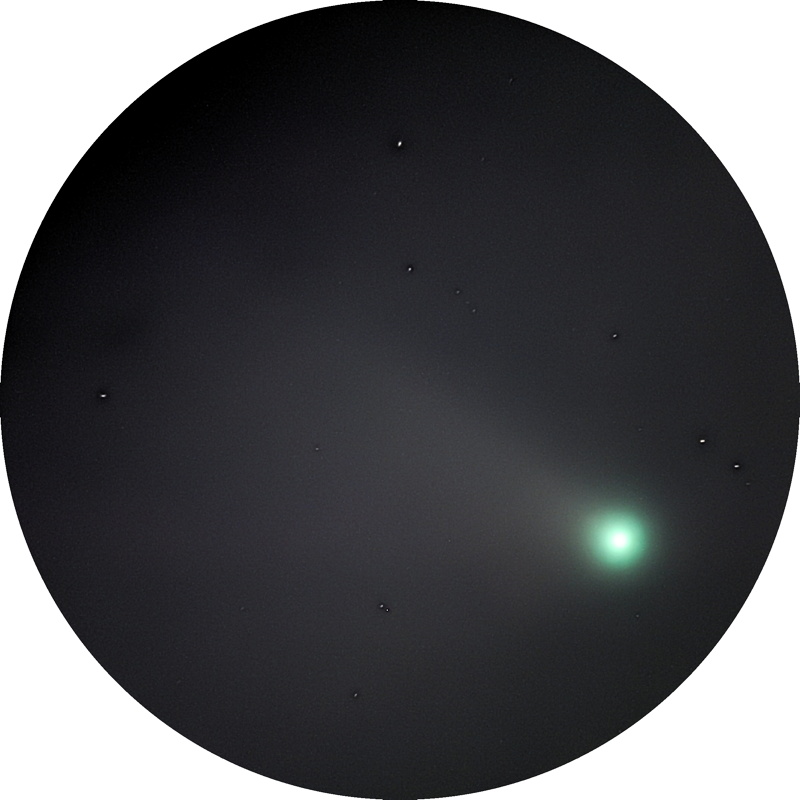iPhone Moon, Comet NEOWISE; D850 DSLR Comet & ISS
Posted: 30 July 2020
Tuesday, 28 July 2020, was cloudy with rain showers in the area. Wednesday, 29 July, dawned clear with clear skies forecast for the next several nights. Daytime temperatures have been 110°F here. Unfortunately, the air conditioner in the observatory can not be used for cooling during the daytime due to an electrical wiring issue that has developed. I hope to get the electrician here soon. I went out to the observatory a little earlier than I normally would to open the dome for a cool down period.
|
Open: Wednesday, 29 July 2020, 1820 MST Temperature: 112°F |
Session: 1503 Conditions: Clear |
Equipment:
12" f/8 LX600 w/StarLock
2" 24mm UWA eyepiece
2" 30mm eyepiece
2" 50mm eyepiece
2" 9mm 100° eyepiece
2" 5.5mm 100° eyepiece
Camera:
iPhone 11 Pro Max
D850 DSLR
After opening the observatory I set up the D850 DSLR outside for my planned sky imaging later in the session.

1837 MST: began relaxing on the observatory patio bench.
1927 MST: sunset.
1928 MST: LX600 ON, StarLock OFF, High Precision OFF.
Viewed the waxing gibbous Moon, 102X, 81X, and 49X. Mounted the iPhone 11 Pro Max on the 30mm eyepiece using the Levenhuk Adapter. Took this afocal 81X image of the Moon using NightCap Camera (ISO 32, 1/350sec, 1X lens).

Then did some lunar observing, 271X and 443X. During momemts of good seeing the craters Copernicus and Clavius looked really nice. Mounted the iPhone on the 2" 5.5mm 100° eyepiece using the Levenhuk Adapter and took these NightCap Camera images (ISO 200, 1/120sec, and ISO 100, 1/120sec, respectively, 1X lens).


2006 MST: back to the bench to wait for the twilight sky to darken.
2020 MST: saw a fast moving, very bright orange colored meteor, with a long trail cross the sky from near Cygnus to Scorpius. The most surprising thing about the meteor was its speed.
2023 MST: viewed Comet C/2020 F3 NEOWISE in my 12x50 binoculars. Only a faint head was visible. I could not see the comet with the naked eye. As it is moving further from the Sun and away from the earth it is fading. The bright moonlit sky does not help.
2025 MST: back inside the observatory.
2026 MST: Stella Wi-Fi Adapter ON.
Used SkySafari 6 Pro on the iPhone to GOTO the comet. Viewed Comet NEOWISE, 102X, 81X, and 49X. A faint tail was visible. Mounted the iPhone on the 50mm eyepiece.
2038 MST: StarLock ON.
Comet NEOWISE, iPhone 11 Pro Max, afocal 49X, NightCap Camera (ISO 6400, 1sec, 1 minute exposure, 1X lens), StarLock autoguided.

Next, mounted the D850 DSLR at prime focus + focal reducer, focused on the star Arcturus, and locked the primary mirror using the ScopeStuff Mirror Lock. Began imaging Comet NEOWISE.
StarLock autoguided, 60 seconds, ISO 2500, White Balance 5560K.

The head is overexposed to bring out the faint tail.
2105 MST: StarLock OFF, Wi-Fi OFF.
2111 MST: began setting up to image the sky from outside of the observatory.
2133 MST: Comet C/2020 F3 NEOWISE (at left), the observatory, and the International Space Station (ISS; right) taken with the D850 DSLR (f/8, 45 seconds, ISO 1600, WB 5560K, FL 14mm UWA lens).

Mouseover or tap on image for labels
As seen at the right in the photo (just above the constellation of Cassiopeia over the tree), clouds were appearing in the sky. By the time I viewed Jupiter with the 12" telescope, 102X, clouds were in much of the sky. Got a brief, cloud covered, look at Saturn, 102X.
2143 MST: LX600 OFF.
|
Close: Wednesday, 29 July 2020, 2152 MST Temperature: 84°F |
Session Length: 3h 32m Conditions: Partly cloudy |
Comments are welcome using Email. Twitter users can use the button below to tweet this report to their followers. Thanks.
Cassiopeia Observatory Home Page
Copyright ©2020 Michael L. Weasner / mweasner@me.com
URL = http://www.weasner.com/co/Reports/2020/07/30/index.html
